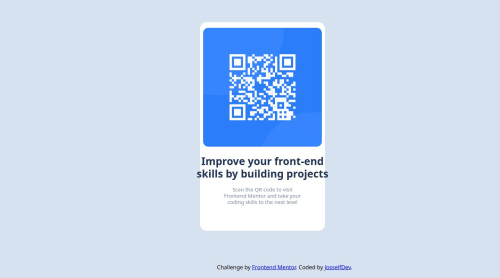
Solution retrospective
Suggest?
Please log in to post a comment
Log in with GitHubCommunity feedback
- P@danielmrz-dev
Hello @Josself!
Your project looks great!
I noticed that you used
positionto place the card in the middle of the page. Here's a very efficient way to center the card:- Apply this to the body (in order to work properly, don't use position or margins):
body { min-height: 100vh; display: flex; justify-content: center; align-items: center; }I hope it helps!
Other than that, great job!
- P@Islandstone89
HTML:
-
Every webpage needs a
<main>that wraps all of the content, except for<header>andfooter>. This is vital for accessibility, as it helps screen readers identify the "main" section of a page. Change.containerinto a<main>. -
The image has meaning, so it must have alt text. Write something short and descriptive, without including words like "image" or "photo". Screen readers start announcing images with "image", so an alt text of "image of qr code" would be read like this: "image, image of qr code". The alt text must also say where it leads(frontendmentor.io).
-
.attributionshould be a<footer>, and its text must be wrapped in a<p>.
CSS:
-
It's good practice to include a CSS Reset at the top.
-
font-sizemust never be in px. This is bad for accessibility, as it prevents the font size from scaling with the user's default setting in the browser. Use rem instead. -
Paragraphs have a default value of
font-weight: 400, so there is no need to declare it. -
Since all text should be centered, you only need to set
text-align: centeron the body, and remove it elsewhere. The children will inherit the value. -
Remove ALL widths and heights in
pxand%. Except for icons, you rarely want to set fixed dimensions(especially heights), as this easily creates issues with responsiveness. On my laptop screen, the text of the card overflows out of the card, because it is taller than the set height of the card. -
Also remove all
positionproperties, they should not be used here. -
As the design doesn't change, there is no need for any media queries. When you do need them, they should be in rem, not px. Also, it is common practice to do mobile styles first and use media queries for larger screens.
-
Add
display: blockandmax-width: 100%on the image - the max-width prevents it from overflowing its container. Remove themarginand the Flex properties. -
To create the space between the image and the edge of the card, set
paddingon all 4 sides of the card. -
To center the card horizontally and vertically, use Flexbox on the body:
display: flex; flex-direction: column; justify-content: center; align-items: center; min-height: 100vh;- Add a
max-widthof around20remon the card, to prevent it from getting too wide on larger screens.
-
- @RomaLetodiani
try decreasing the font-size of title
Join our Discord community
Join thousands of Frontend Mentor community members taking the challenges, sharing resources, helping each other, and chatting about all things front-end!
Join our Discord